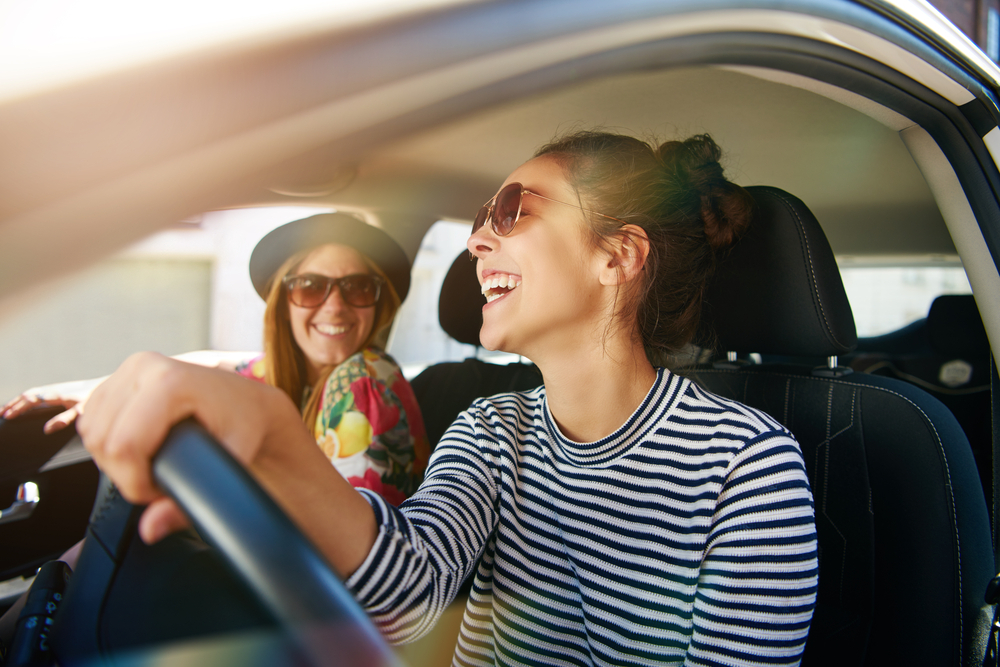Sometimes it's obvious that you need to protect your skin from ultraviolet (UV) radiation, like when you're spending a day at the beach or taking a hike on a sunny day. Other times, you may need a gentle reminder, like when you're driving to and from work.
Seeing as you're technically inside while driving, it can be unclear whether or not you need to consider sun care. Do car windows block UV radiation? Can you get sunburned through a car window? Read on to get these burning questions answered and discover some easy tips to help you protect your skin.
How to Maximize Sun Protection While Driving
So, do car windows block UV rays? The answer is some, yes—but not all. According to the Skin Cancer Foundation, glass can block UVB rays (those responsible for sunburn) fairly well. It doesn't, however, block the UVA rays that cause deeper structural skin damage and premature aging. That's why it's still important to protect your skin from the sun when traveling around in the car. UVA rays are present throughout all four seasons and can even penetrate stormy gray clouds.
Use Sun Sleeves and Window Shields
The most effective way of blocking UV rays from coming through car windows is by wearing a sun sleeve or using a window shield, which can be easily attached and removed depending on where you're sitting in the car. Don't forget to place window shields in the back, too—especially if you have a baby or young child, as their skin is particularly vulnerable to UV damage.
Apply Broad-Spectrum SPF
Given that UV radiation can reach your skin all year round, it's important that you slather on protection every morning with a broad-spectrum sunscreen. A product like EltaMD's UV Luminous Broad-Spectrum SPF 41 is specifically designed for your face and features a light, rosy tint that helps to blur imperfections. Its formula also contains antioxidants, like Linoleic Acid and Vitamin E, to help defend the skin from free radicals and diminish UV-related signs of aging. Remember to also apply it to the back of your neck, ears, chest, hands, and any areas of exposed skin before you hop in the car. You can also leave a small tube in the glove compartment so you can reapply on long journeys.
Wear UV-Protective Sunglasses
Every glove box should contain a pair of sunglasses to protect the eyes from UV damage and the glare of the sun, which can affect visibility. In fact, it's important that you protect the skin on and around your eyes in the same way you do the rest of your face. This is because invisible UV rays can cause DNA changes, skin cancer, and premature aging on the eyelids and delicate eye area. Overexposing your eyes to the sun can also lead to sunburn on the outer layer of the cornea (a condition called photokeratitis), as well as other health problems, like cataracts.
To ensure your sunglasses are providing you with adequate protection, look for labels that state the lenses have 100 percent UVA and UVB protection, or 100 percent protection against UV 400. This means they'll filter out 99 percent of UV rays. Wraparound sunglasses can also stop UV rays from reaching your eyes from the sides, which is a good option if you spend a lot of time in the car.
Cover Up Exposed Skin
There's nothing better than driving with the windows down and feeling the breeze on your skin on a warm summer day. But, if you're doing this every day without wearing sunscreen or covering your skin, you'll be more at risk of sunburn in the short term and cumulative sun damage in the long term. You can avoid this simply by applying a broad-spectrum sunscreen to areas of exposed skin and covering up in light layers wherever possible.
Now that you know how UV rays can impact your skin when traveling in the car, you should be able to take some simple actions to protect the whole family. Make a checklist before long journeys so you don't forget any of the essentials: sunscreen, window shields, a long-sleeved top, and UV-protective sunglasses. And remember, these tips still apply throughout the year, including on snowy winter days.
